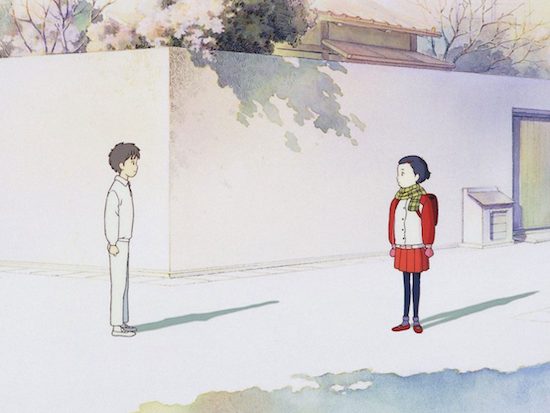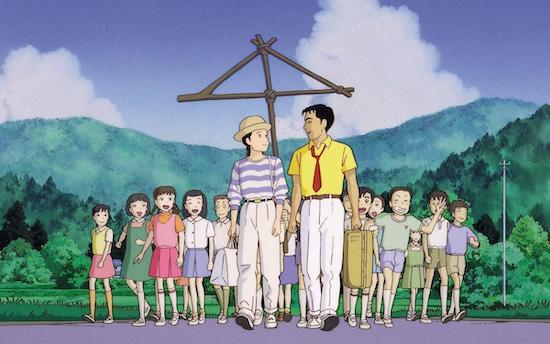It’s 1966, and 10-year-old Taeko has failed a maths test. Her mother, washing dishes in the kitchen, asks one of Taeko’s older sisters to help.
The sister is horrified. “Is she alright in the head?” she asks. “Normally this is easy.”
“But that child’s not normal,” her mother says, just as Taeko comes downstairs into the room. Taeko freezes on the last step. She’s only held there a few seconds, but it feels like a lifetime.
Quiet domestic scenes like this are scattered in flashback throughout Only Yesterday, which celebrates its thirtieth birthday on 20th July. These small, low-key moments of drama are typical of a film which prioritises intimacy and self-reflection over conflict and action: the antithesis of almost everything we expect an animation to be.
Taeko, in the film’s present, is a 27-year-old single woman living alone in Tokyo. She has a good office job and a comfortable life. While not unhappy, she is unfulfilled. For the second summer running, she is to spend her 10-day holiday working on a safflower farm a couple of hundred miles north of the city. There, the film explores her growing sense of emotional and spiritual completeness – and deepening friendship with the farmer’s son Toshio, himself a former office worker who grew tired of city life. Interwoven with this storyline are those flashbacks, and Taeko’s memories of her 10-year-old self. (The Japanese title Omohide Poro Poro, loosely translates to “Memories raining down”.) Taeko’s identity isn’t so much rooted in her past as it is trapped in it.
Only Yesterday broke new ground: it was aimed primarily at an adult demographic, and explored themes usually the preserve of live-action films: regret and melancholy, disappointed hopes, the struggle to find your way in life on reaching adulthood. The film was directed by the late Isao Takahata, the co-founder of Studio Ghibli, from a 1982 manga by Hotaru Okamoto and Yuko Tone, which covers Taeko’s episodic travails as a 10-year-old; the adult Taeko and her troubles are Takahata’s invention. But it was Hayao Miyazaki, Takahata’s long-time colleague and sometime rival at Ghibli, who first saw the possibility of adapting it into an anime. “It would have some value if we portrayed kids like these in a film,” Miyazaki said in a ‘Making of…’ documentary that accompanied the film’s release. “But I couldn’t do it. I don’t have such skills. And the only person that seemed to have such skills was Takahata.”
Time and again in his career, Takahata had shown that anime had the subtlety and complexity to address topics commonly thought the preserve of live-action film. His first film, 1968’s Horus, Prince of the Sun was a commercial failure; but it was a revelation to a rising generation of animators. “[He] really proved that animation has the power to depict the inner mind of humans in depth,” Miyazaki later wrote. Takahata went on to show that the intimacy and expressiveness of hand-drawn film-making made it arguably a better vehicle for such themes than live action – most famously in the unsparing realism of 1988’s Grave of the Fireflies, whose evocation of the plight of two lost children in the last months of the second world war is as emotionally shattering as cinema gets. “Live-action films are so common these days that they’re becoming a part of reality,” Takahata told the documentary team in 1991. “I don’t think audiences really ‘watch’ live-action features carefully. However, they’d be forced to for an anime feature. Because anime captures what we do, and reflects [a] more solid reality… it makes people realise what we do every day.” To put it another way, the very unreality of animation, its obvious artifice, makes us observe the beauty and truth of what it represents more closely.

Which brings us back to Only Yesterday, Takahata’s next film after Grave of the Fireflies. It’s the first of his works to use the nature of the medium – the hand-drawn art of line and colour – not simply to reflect reality, but to elucidate it. There are three landscapes in the film: the urban landscape of the city where Taeko lives, the rural landscape she visits, and the hazy, vertiginous landscape of memory. The visceral beauties of the first two are rendered with all the characteristic artistry of Ghibli at its finest: trainyards, puddled streets, safflower fields – all their realities so exquisitely visualised that we find ourselves startled by the loveliness of the most mundane things. But the landscape of memory is treated differently: the colour palette is pared back to more muted, pastel tones; often parts of the screen are left blank, incomplete, the foreground dissolving into negative space, the backgrounds barely sketched, implicit and unrealised. It’s a highly evocative technique emphasising the emotional precision of memory, its aversion to sensory abundance and detail, even as it replicates it. And, paradoxically, by encouraging the viewer to look closer, to engage creatively with what we see, the deliberate unrealism of the imagery deepens the emotional realism we experience. “I [aim] to have the audience vividly imagine or recall the reality deep within the drawings, rather than thinking the drawings themselves were the real thing,” Takahata told Wired in 2015.
If greater artifice addressed the challenges Takahata set himself in representing reality in anime, art – in its broadest sense – is an answer to the question Only Yesterday keeps asking us: how do you create meaning from life? For Taeko, the answer lies in a connection with the deep rhythms and everyday wonders of the natural world which, the film makes clear in one of its earliest scenes – when Taeko’s hopes of a holiday in the countryside are dashed – she had always sought, and been denied, as a child. But the nature that satisfies the 10-year-old inside her is no wilderness: it is explicitly a man-made environment. “City people see the trees and the rivers and are grateful for ‘nature,’” Toshio tells her as they gaze out over a landscape of fields, woodland and waterways. “But what you see here is all made by… farmers. Every bit has its history, not just the fields and rice paddies. Someone’s great-great-grandpa planted it or cleared it.” You could call this landscape a construct; but you could also call it art.
Art is everywhere in Only Yesterday, mediating memory, experience and emotion alike. When Taeko’s memories first come flooding back, there are, she says, “so many little details one after the other, playing in my head like a movie – almost overpowering me.” Art and life intertwine: crows in the evening sky remind her of a school play, when her performance in a minor role won her a professional part – only for her father to forbid it. Crushed by the familiar denial of her hopes, she takes heart from the words of a song from a children’s TV puppet show, the real-world 1960s Japanese show Hyokkori-Hyoutanjima: “We hate to cry, so we’ll laugh instead.” Toshio photographs her with the farmers, art and memory meeting as the shutter clicks. The first time they meet, they discover they have both just read a Basho haiku about safflowers; the poet helps them make sense of the flower, its place in Japanese culture.
For Takahata, Only Yesterday was both a transformational and a transitional film. It was his first major box-office hit, and he emerged from it fully formed as a film-maker at the forefront of Japanese animation. But ultimately, Only Yesterday is not a masterpiece because of its innovation: it’s an emotionally profound and structurally satisfying piece of storytelling, made whole by all sorts of deft connections, arcs and echoes. Taeko’s holiday is 10 days long. But in cinematic terms it plays out over the arc of a day, from her arrival pre-dawn on the night train from Tokyo, to the moment sitting in the car with Toshio the night before her departure when she realises she may have feelings for him. A butterfly drifts from Taeko’s schooldays and the safflower fields to her train journey home where the gentle and lovely redemption on which the film closes – so underplayed that it runs beneath the final credits – takes place.
The ambition and ability to realise psychological complexity may have been Takahata’s principal gift to anime; but his relentless search for new techniques, for radical new, deeper ways to communicate love and hope, happiness and loss – the fully human life – through line and movement, was a gift too. And that dogged pursuit of the line, its purity, its naked expressiveness, its capacity for revealing truth without having to represent it, is never more eloquent or moving than in Only Yesterday. As Takahata told French anime magazine AnimeLand in 1992: “Try to remember one thing, which counts the most: it is not the real, nor even the relationship with the real; it is only the line and the way of drawing.”


